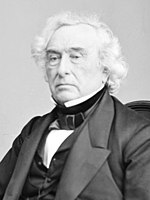Election
When Tallmadge's name was brought forward in the Legislature, members of the opposition, among them Isaac L. Varian and John C. Spencer, objected, arguing that Tallmadge as a State Senator was constitutionally ineligible. The State Constitution of 1821 provided in § 10 that "no member of the Legislature shall receive any civil appointment ... from the Legislature, during the term for which he shall have been elected," which supports this point of view. On the other side, § 11 provided that "if any person shall, while a member of the legislature, be elected to Congress ... his acceptance thereof shall vacate his seat," which considers the possibility of such an election. The majority decided that Tallmadge was eligible. However, a large minority of State legislators insisted that Tallmadge was ineligible, § 11 applying only to U.S. Representatives elected by popular vote, and refused to vote.

Nathaniel Pitcher Tallmadge was an American lawyer and politician. He served two terms as United States Senator from New York (1833–1844) and was the 3rd Governor of the Wisconsin Territory (1844–1845).

The 1825/1826 United States Senate election in New York was held on February 1, 1825, and January 14, 1826, by the New York State Legislature to elect a U.S. Senator to represent the State of New York in the United States Senate.

The 1829 United States Senate special election in New York was held on January 15, 1829, by the New York State Legislature to elect a U.S. Senator to represent the State of New York in the United States Senate.

The 1831 United States Senate election in New York was held on February 1, 1831, by the New York State Legislature to elect a U.S. Senator to represent the State of New York in the United States Senate.

The 1833 United States Senate special election in New York was held on January 4, 1833, by the New York State Legislature to elect a U.S. Senator to represent the State of New York in the United States Senate.

The 1837 United States Senate election in New York was held on February 7, 1837, by the New York State Legislature to elect a U.S. Senator to represent the State of New York in the United States Senate.

The 1839—1840 United States Senate election in New York was held on February 5, 1839 and January 14, 1840. Incumbent Senator Nathaniel P. Tallmadge was re-elected to a second term in office over scattered opposition.

The 1845 United States Senate special election in New York was held on January 18, 1845 by the New York State Legislature to elect two U.S. Senators to represent the State of New York in the United States Senate. The regular 1845 United States Senate election in New York was held on February 4, 1845, to elect a U.S. Senator to represent the State of New York in the United States Senate.

The 1857 United States Senate election in New York was held on February 3, 1857 by the New York State Legislature. Incumbent Whig Senator Hamilton Fish did not stand for re-election. The seat was won by Preston King, a former U.S. Representative and member of the newly-formed Republican Party. King was the first Republican elected to represent New York, although William H. Seward had joined the party after being elected as a Whig in 1855.
The United States Senate elections of 1856 and 1857 were elections which had the young Republican Party assume its position as one of the United States's two main political parties. The Whigs and Free Soilers were gone by the time the next Congress began.
The United States Senate elections of 1840 and 1841 were elections which, corresponding with their Party's success in the 1840 presidential election, had the Whig Party take control of the United States Senate.
The United States Senate elections of 1838 and 1839 were elections which had the Democratic Party lose seven seats in the United States Senate, but still retain a majority.
The United States Senate elections of 1836 and 1837 were elections that had the Jacksonian coalition emerge as the Democratic Party, and the Adams, or Anti-Jackson, coalition emerge as the Whig Party
The United States Senate elections of 1832 and 1833 were elections that had the Anti-Jacksonian coalition assume control of the United States Senate from the Jacksonian coalition, despite Andrew Jackson's victory in the 1832 presidential election.

The 47th New York State Legislature, consisting of the New York State Senate and the New York State Assembly, met from January 6 to November 27, 1824, during the second year of Joseph C. Yates's governorship, in Albany.

The 53rd New York State Legislature, consisting of the New York State Senate and the New York State Assembly, met from January 5 to April 20, 1830, during the second year of Enos T. Throop's governorship, in Albany.

The 56th New York State Legislature, consisting of the New York State Senate and the New York State Assembly, met from January 1 to April 30, 1833, during the first year of William L. Marcy's governorship, in Albany.

The 57th New York State Legislature, consisting of the New York State Senate and the New York State Assembly, met from January 7 to May 6, 1834, during the second year of William L. Marcy's governorship, in Albany.

The 62nd New York State Legislature, consisting of the New York State Senate and the New York State Assembly, met from January 1 to May 7, 1839, during the first year of William H. Seward's governorship, in Albany.

The 68th New York State Legislature, consisting of the New York State Senate and the New York State Assembly, met from January 7 to May 14, 1845, during the first year of Silas Wright's governorship, in Albany.







